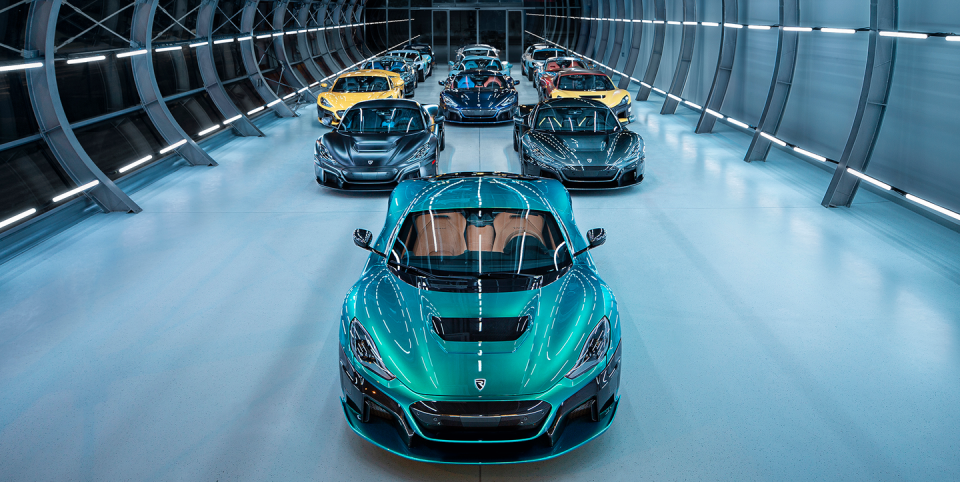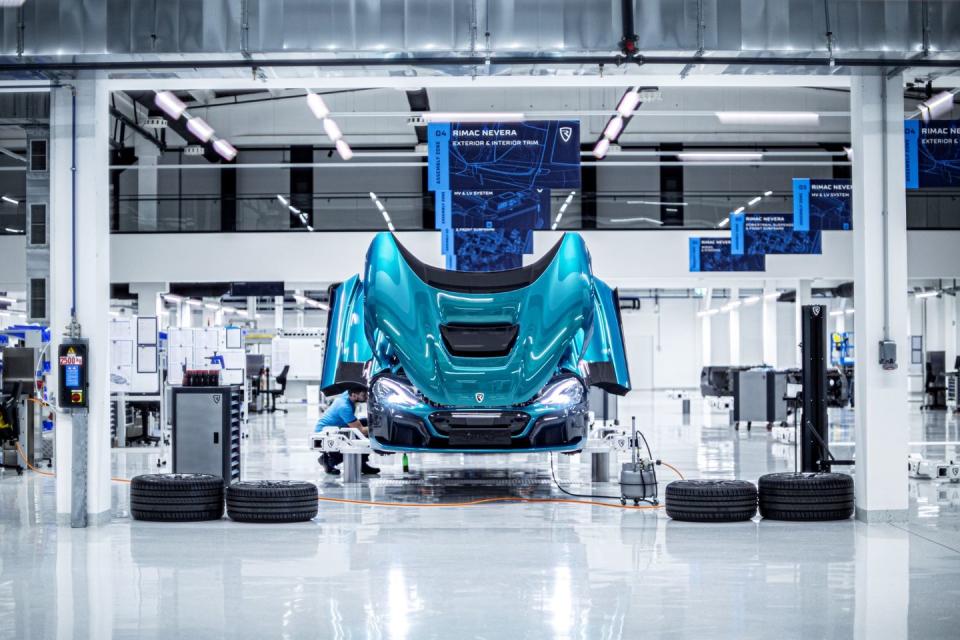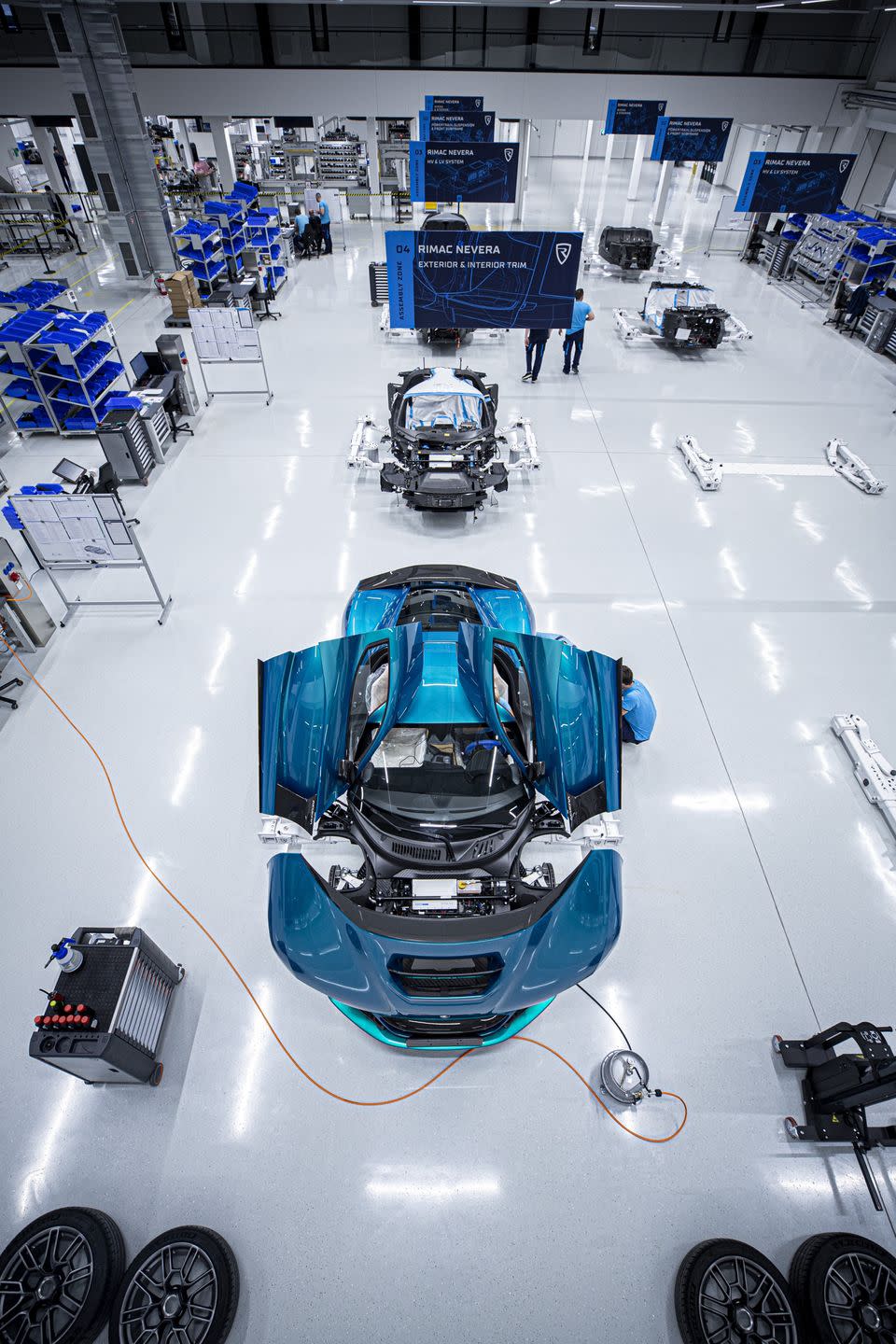The Rimac Nevera Is Officially Here

After five years of development, Mate Rimac's brainchild all-electric hypercar, the Rimac Nevera, is finally in production.
The 150-unit limited run of Rimac Neveras will be produced over three years, with each of the 150 bespoke models differentiated by interior trim options.
With 1914 all-electric horsepower, reactive torque vectoring, and a carbon fiber monocoque chassis, the Nevera ushers in a new era of super performance at the cost of $2.4 million.
As the first round of production-grade Rimac Neveras rolls off the production line in Zagreb, Croatia, CEO Mate Rimac wants you to know it wasn't without difficulty. Having been through a five-year development process, the company endured 45 physical crash tests, 18 prototypes, and three different powertrains. In spite of this, and with the newfound ability to crank out 50 hand-built units a year, the Rimac Nevera will be in production for three years.
This is good news for enthusiasts worldwide, seeing as the Nevera represents a turning point in the world of performance vehicles. The four-motored, 120-kWh all-electric hypercar produces an astounding 1914 hp and 1740 lb-ft of torque, but the technological advancements go beyond the numbers.
Nearly every major component of the car was custom built: an entirely new-generation battery system, inverter, gearbox, electric motor, and control systems were created for the Nevera. This translates into the unique driving dynamics of the carbon-fiber monocoque, with an electric motor at each wheel working with the programmed control systems to create constantly adapting torque vectoring. Even with a hefty curb weight of 4740 pounds, the Rimac has proven itself to be razor-sharp at events like the Goodwood Festival of Speed.

“At the beginning of the Nevera journey, we ran thousands of virtual simulations and experimented with countless designs before eventually, the time came to create the very first working prototypes," Rimac said in the official production announcement. "The Nevera was developed with the intention to become the cutting-edge electric hypercar it is today, ready to thrill drivers and passengers in a way they have never experienced before."
The testing of these working prototypes included the destruction of nine pre-production units through multi-national crash testing, cold testing at the arctic circle, and hot testing at 118.4°F. As the crash tests yielded passing results, customers put down deposits for the car with the claim to the world's fastest acceleration. For the price of $2.4 million, it is unlikely customers would settle for anything less than comprehensive testing across the board.

The first year of production units are officially sold out, and the company is said to be on track for delivery this year. With 36 different pre-defined paint colors or the chance to go bespoke, Rimac offers customers a selection of in-house-designed liveries, three levels of exposed carbon fiber, and an enormous selection of leather and Alcantara microsuede interior touch points with brushed aluminum finishes. The company is dedicated to producing 150 unique vehicles and the breadth of options available makes this goal possible if a bit laborious for future customers.
For those awaiting deliveries, Rimac's dealership network and mobile service department are largely developed. Proprietary digital diagnostic tools will allow Rimac to monitor and update the cars remotely. Each of the 25 dealer partners across the US, Europe, Middle East, and Asia will be specifically trained on detailed service and repair information in addition to the dedicated Rimac Service Team, who will travel worldwide to diagnose potential problems. "The target is that the experience of owning a Nevera will be just as extraordinary as driving it," the company's press release states.
If you want to see an in-depth breakdown of the manufacturing process, the YouTube video above gives viewers a peek into the pre-production processes and Rimac's eventual choice to go with a production line-style facility. Twelve years since its inception, Rimac Automobili has grown from a fledgling startup to a company with over 1500 employees and a 320,000-square-foot design and production campus in the works.
A successful production run of Rimac Neveras signals a victory for founder Mate Rimac. A series of lost investments, a high-profile crash, and speculated acquisitions were bumps in the road for Rimac, as he followed his dream of creating an electric hypercar in his childhood homeland of Croatia.
The Nevera will not be alone in this rarefied market: The 1900-hp Pininfarina Battista, an Italian electric hypercar using the same platform and 120-kWh battery as the Rimac, is also on track to begin production of its 150-unit limited run shortly.

 Yahoo Autos
Yahoo Autos 